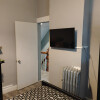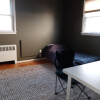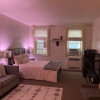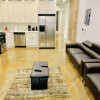1 Rental Property rented out in district / neighbourhood Greenwich Village in New York
Living in the district / neighbourhood Greenwich Village in New York
About the district / neighbourhood Greenwich Village in New York
Greenwich Village, often simply called "The Village," is a historic and culturally significant neighborhood in Lower Manhattan, New York City. Known for its artistic legacy, bohemian past, and charming tree-lined streets, Greenwich Village has long been a hub for creative minds, countercultural movements, and progressive activism. The neighborhood’s cobblestone streets, brownstone townhouses, and vibrant social scene make it one of the most beloved and iconic parts of New York City. History of Greenwich Village
Greenwich Village dates back to the 17th century, when it was a rural hamlet separate from the growing city of New York. It became part of New York City in the 19th century but maintained its distinctive street layout, which doesn’t follow the orderly grid pattern found elsewhere in Manhattan. By the early 20th century, the neighborhood became a magnet for artists, writers, and musicians, establishing its reputation as a bohemian enclave.
Throughout the 20th century, Greenwich Village played a pivotal role in numerous social and cultural movements, including the beatnik scene of the 1950s, the counterculture of the 1960s, and the gay rights movement, solidifying its identity as a progressive, artistic community. Landmarks and Points of Interest
Washington Square Park: Washington Square Park is the heart of Greenwich Village and one of New York City’s most famous public spaces. Dominated by the iconic Washington Square Arch, which was built in 1892 to commemorate the centennial of George Washington’s inauguration as president, the park is a vibrant gathering spot for locals, street performers, and tourists alike. The park has a long history of being a center for protests, performances, and social gatherings, contributing to its reputation as a symbol of free expression and countercultural activity.
Stonewall Inn: Located on Christopher Street, the Stonewall Inn is one of the most important landmarks in LGBTQ+ history. In June 1969, a police raid on the gay bar sparked the Stonewall Uprising, a pivotal event in the fight for LGBTQ+ rights. The protests that followed marked the beginning of the modern gay rights movement. Today, the Stonewall Inn is a designated National Historic Landmark, and the annual Pride Parade in New York City commemorates the events that took place there.
New York University (NYU): NYU’s campus is deeply integrated into Greenwich Village, with many of its buildings surrounding Washington Square Park. The presence of NYU students and faculty has long influenced the area’s intellectual and artistic atmosphere. The university also hosts numerous cultural events, performances, and lectures that contribute to the neighborhood’s dynamic energy. NYU’s Skirball Center for the Performing Arts and Grey Art Gallery are important cultural venues that showcase theater, art, and music.
The White Horse Tavern: Opened in 1880, the White Horse Tavern is one of New York’s oldest bars and a famous literary haunt. It was frequented by poets and writers such as Dylan Thomas, Jack Kerouac, and James Baldwin. Known for its literary history, the White Horse Tavern has retained its old-world charm and remains a popular spot for both locals and tourists looking to soak in the Village’s artistic past.
The Village Vanguard: The Village Vanguard is a legendary jazz club located on Seventh Avenue South. Opened in 1935, it is one of the oldest jazz clubs in the world and has hosted performances by some of the greatest musicians in jazz history, including John Coltrane, Miles Davis, and Bill Evans. The club’s intimate setting and stellar lineup continue to make it a mecca for jazz enthusiasts.
Jefferson Market Library: Originally built in 1877 as a courthouse, the Jefferson Market Library is a striking Gothic Revival building located at Sixth Avenue and 10th Street. After the courthouse was decommissioned, the building was saved from demolition and repurposed as a public library. Today, it serves as a community hub and is an architectural gem, noted for its tall clock tower and intricate design.
Bleecker Street: Bleecker Street is one of the most famous streets in Greenwich Village, known for its eclectic mix of shops, cafés, restaurants, and music venues. In the 1960s, it was a major center of the folk music scene, with artists like Bob Dylan and Joan Baez performing in clubs like The Bitter End. Today, Bleecker Street maintains its creative spirit and is a great place to explore the neighborhood’s cultural offerings.
Conclusion
Greenwich Village’s bohemian charm, rich history, and cultural landmarks make it one of the most iconic neighborhoods in New York City. From the activist roots of the Stonewall Inn to the artistic legacy of places like Washington Square Park and The Village Vanguard, the neighborhood remains a symbol of creativity, free expression, and community spirit. Whether you're interested in history, the arts, or just want to experience the Village's unique atmosphere, Greenwich Village is a must-visit destination in New York.























